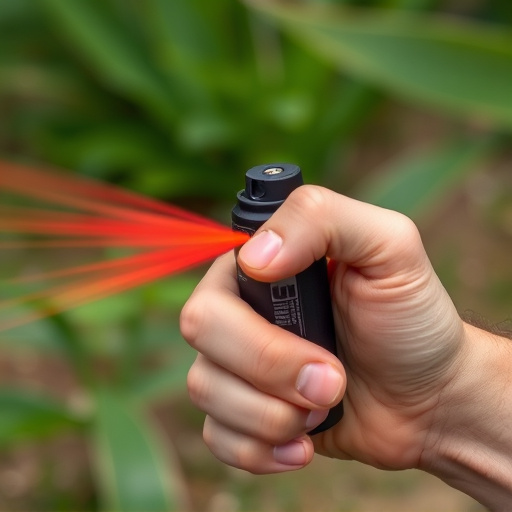TL;DR:
Understanding how to treat pepper spray exposure is crucial, especially in cases of accidental or unjustified exposure. Immediate actions include moving to fresh air, removing contaminated clothing, and washing eyes with water for 15 minutes. For severe reactions, seek medical attention, as symptoms can persist and lead to health complications, particularly in individuals with respiratory conditions. Treatment involves diluting the chemical agent, using cool compresses, staying hydrated, and taking antihistamines. Legal use of pepper spray requires responsible application guidelines, and prompt action is vital for both law enforcement and citizens exposed to it.
“Discover the powerful compound behind pepper spray and its profound effects. This comprehensive guide unravels the chemical composition of police-grade inflammatory spray, shedding light on how it works and its potential risks. Learn immediate first aid steps for effective treatment after exposure, including managing symptoms and seeking medical care. Explore long-term strategies for recovery from persistent irritation. Additionally, understand the legal considerations surrounding pepper spray usage, ensuring knowledge of its application within the law. Find out How to Treat Pepper Spray Exposure effectively.”
- Understanding Pepper Spray Compound: Chemical Composition and Effects
- Immediate Steps After Exposure: Symptoms and First Aid
- Long-term Care and Recovery: Treating Persistent Irritation
- Legal Considerations: When and How to Use Pepper Spray Legally
Understanding Pepper Spray Compound: Chemical Composition and Effects
Pepper spray, a powerful law enforcement tool, is composed of capsaicin, a chemical extracted from chili peppers. This compound stimulates nerve endings, causing intense irritation and pain in the eyes, nose, and respiratory system. When exposed to pepper spray, individuals experience temporary blindness, coughing, difficulty breathing, and severe discomfort.
Knowing how to treat pepper spray exposure is crucial. In cases of accidental or unjustified use, immediate steps can include removing contaminated clothing, washing eyes with plenty of water for at least 15 minutes, and seeking fresh air. Medical attention may be required for severe reactions, ensuring the safety and well-being of those affected.
Immediate Steps After Exposure: Symptoms and First Aid
After exposure to pepper spray, immediate action is crucial for effective first aid and to mitigate discomfort. If someone comes into contact with pepper spray, they should immediately move to a safe, open area away from potential sources of ignition or heat, as the compound can be volatile. Removing contaminated clothing and washing eyes thoroughly with clean water for at least 15 minutes is essential. This process helps to dilute the chemical agent and alleviate symptoms.
For respiratory irritation, affected individuals should breathe slowly and deeply into their diaphragm, avoiding rapid breathing which can exacerbate coughing fits. Applying a cool, wet compress to the face and neck areas can provide some relief from skin irritation. It’s important to seek medical attention if symptoms persist or worsen, as pepper spray exposure may lead to more severe health complications, especially in individuals with pre-existing respiratory conditions. How to treat pepper spray exposure effectively involves prompt action, proper washing, and accessing professional medical care when necessary.
Long-term Care and Recovery: Treating Persistent Irritation
Pepper spray exposure can lead to long-term irritation and discomfort for some individuals, making it crucial to understand how to treat such cases effectively. The initial response to pepper spray often includes eye watering, coughing, and difficulty breathing, but if these symptoms persist, it may indicate a more severe reaction. It’s important to seek medical attention immediately if the exposure results in persistent respiratory distress, chest pain, or any signs of an allergic reaction.
Treating pepper spray exposure involves several steps, including removing contaminated clothing and thoroughly washing the affected areas with water. Over-the-counter antihistamines can help alleviate itching and irritation, while cool compresses may provide some relief for skin discomfort. For more severe cases, a healthcare professional might prescribe stronger medications to manage inflammation and discomfort. Hydration is key; drinking plenty of fluids helps thin mucus and ease breathing difficulties that can persist after exposure.
Legal Considerations: When and How to Use Pepper Spray Legally
When it comes to using pepper spray, law enforcement agencies and individuals must navigate a complex web of legal considerations. The application of such force is subject to strict guidelines and regulations, ensuring its responsible use. To employ pepper spray legally, officers typically require specific training and certification, covering scenarios like self-defense, crowd control, or responding to violent situations. The use of pepper spray must be proportionate and necessary, adhering to the principles of minimum force required to achieve the intended outcome.
In terms of how to treat pepper spray exposure, both for individuals and bystanders, prompt action is crucial. If exposed, affected persons should immediately seek fresh air by moving to an open area. Removing contaminated clothing and washing eyes and skin with plenty of water can help alleviate symptoms. In cases of severe respiratory distress or prolonged exposure, medical attention is essential. Understanding the legal boundaries and knowing how to manage pepper spray exposure are vital aspects for both law enforcement and citizens alike.
Understanding pepper spray compound, its composition, effects, and legal considerations is paramount for both users and bystanders. Knowing immediate first aid steps and long-term care guidelines is essential for managing exposure effectively. By adhering to these practices and staying informed about local regulations, individuals can ensure safer use of pepper spray while promoting responsible handling and treatment of potential exposure. For any instance of pepper spray contact, how to treat pepper spray exposure remains a crucial skill, enabling prompt and effective care.
